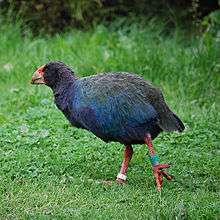Tiritiri Matangi Island
Tiritiri Matangi is an island and nature reserve in the Hauraki Gulf near Auckland in New Zealand. It is 30 km NE of Auckland and 4 km from Whangaparaoa Peninsula.
Understand

Tiritiri Matangi is one of only two scientific reserves in New Zealand that are open to the public. It has been created as a predator-free sanctuary to enable endangered species to thrive.
There are 78 species of birds that have been seen on or near Tiritiri Matangi. These include little spotted kiwi, takahe, kokako, stitchbird, tui, saddleback, North Island robin, brown teal, bellbird and fantail. The island is a highlight for birdwatchers.
The island is 220 hectares in area. Farming destroyed most of the native bush during the last century. Since being placed under the care of the Department of Conservation, volunteers have planted between 250,000 and 300,000 trees which have forested about 60% of the island. The other 40% remains as grassland for the takahe. (The takahe was presumed to be extinct until it was "rediscovered" in the Murchison Mountains of Fiordland in 1948.)
The island is rubbish free. Take out what you bring in. There are no dustbins. There are toilets on the ferry, at the shop/lighthouse and at Hobb's Beach on the island. Smoking is not allowed except at the wharf and the lighthouse. Take the butts home with you. Animals are not allowed.
There is a limit of 150 visitors a day.
Remember a hat, sunblock, some warm clothes and a rain jacket. Binoculars are useful for bird viewing.
Get in

Get there by 360 Discovery ferry, 75 minutes from Auckland or 20 minutes from Gulf Harbour on Whangaparaoa Peninsula. The ferry departs W-Su and public holidays at 9AM from Auckland and 9:50AM from Gulf Harbour Marina. It departs Tiri to return at 3:30PM. The cost is $70 per adult and $40 per child from Auckland, and $55 per adult and $32 per child from Gulf Harbour. Bookings are essential. Sailings are subject to weather conditions. To check if your sailing is going ahead call 0800-FANTAIL (0800-326824) (NZ only) after 7AM on the day.
There is an optional guided walk that lasts an hour and costs $5 for adults and $2.50 for children – this must be purchased at the time of making your ferry reservation.
Hauraki Adventures can also drop you off there.
See
The stunning views over the gulf, plant and bird life and the lighthouse (which still functions). Dolphins, stingrays and orca are often seen near the wharf.
Do
- There are a number of walks, which range up to 4–5 hours. A brochure that includes a detailed map can be purchased for $1 from the shop, the Fuller's ferry ticket office or en route on the ferry.
- Walk up to the lighthouse. Built in 1864, it is one of the oldest in New Zealand and the tallest one easily accessible to the public. It is 21 m tall. The xenon gas lamp installed in 1965 was reputed to be the brightest in the Southern Hemisphere. It has been replaced by a quartz iodine light. The lighthouse is now fully automated. Solar power is used.
Buy
A shop near the lighthouse sells souvenirs, cold drinks and complimentary tea and coffee, but no food. It accepts cash or credit cards but EFTPOS is not available. All profits support the conservation effort.
Eat
Bring your own. All food must be packed in sealed boxes (e.g. lunch box). No plastic bags. This is to keep the island rodent free.
Sleep
- 🌍 DOC Tiritiri Matangi Island bunkhouse, ☎ +64 9 476 0010, e-mail: tiritirimatangifb@doc.govt.nz. Overnight accommodation is available in a four room bunkhouse. It is equipped with cooking utensils, fridge, gas stove and BBQ. There is hot water in the showers. Bring your own sleeping bag, pillow case and torch. Bring food for your stay and one day's spare in case of delays.
Go next
- Return to Auckland
- Great Barrier Island
- Waiheke Island